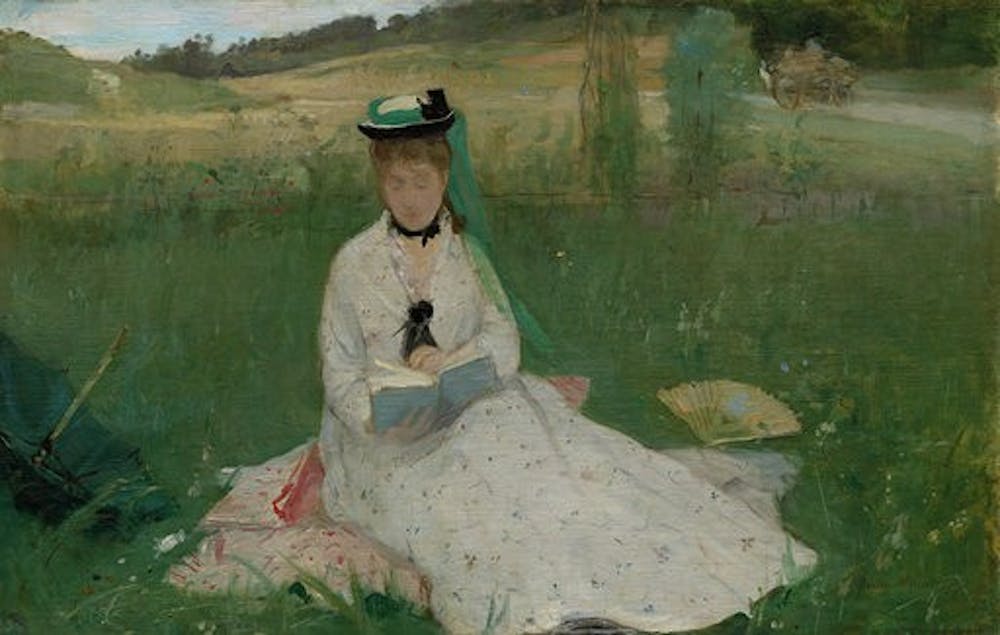She looked to me like the swirling sea creature of Edvard Munch’s “Mermaid,” reminding me immediately of that heartbreaking final stanza of Prufrock. The soft transition from her orange hair to the haunting green background around her made her pale skin look sickly and melancholic—the hand supporting her tilted head further underscoring this feeling of teenage malaise. Her eyes, gazing back half–open at the viewer, communicated all of the beauty and strength and sadness that exist in all young women. She was Berthe Morisot’s daughter, Julie, the subject of the artist’s 1894 painting, “Portrait of Miss J.M. (Julie Dreaming),” the concluding work of the Barnes Foundation’s most recent exhibition, Berthe Morisot: Woman Impressionist.
Having opened this past Sunday at the Barnes, this new touring exhibition premiered at the Musée national des beaux–arts de Québec last June, and will continue on to the Dallas Museum of Art and the renowned Musée d’Orsay in 2019. Comprised of nearly 70 paintings from public and private collections, Berthe Morisot: Woman Impressionist seeks to highlight the role and influence of Morisot in late nineteenth century art, which the curators of the exhibition argue have perhaps been diminished by past scholars because she was a woman. At the Barnes Foundation, in particular, which is home to a surplus of works from heavyweights like Renoir and Cézanne, this special exhibition is meant to demonstrate by direct comparison that Morisot’s innovation was equally as impressive as her male contemporaries, if not more so.
The first gallery centers on what is probably Morisot’s most well–known work, “The Cradle.” This painting hung above my own cradle, and later my bed, throughout my childhood. On a vacation to France while pregnant with me, my mother purchased a framed copy of “The Cradle,” most likely thinking its depiction of motherhood suited the nursery she had so carefully crafted for me. It was the first piece of fine art I ever saw, and on a morning when I felt particularly homesick, finally witnessing its brushstrokes in person moved me in such a way that I longed to be simultaneously at home and in front of this painting forever.
I digress, but this is the kind of visceral response that Morisot’s work provokes in this exhibition. The 1872 piece displays both her expert craft in painting complex elements like the thin transparent veil over the baby’s cradle, and the melancholic attitude of the mother, who happens to be Morisot’s sister Edma. In this ambiguously unhappy expression, Morisot questions the meaning of maternity and its expectations in the French bourgeois lifestyle of this period.
Split into seven categories that roughly follow the chronology of Morisot’s career, the exhibition highlights both her advancement of techniques in plein air painting and her more nuanced depiction of female household servants. Beyond experimenting with the depiction of women in art, she also pushed the boundaries of the foundation of Impressionism itself, questioning what it means to try and capture an immediate reaction to a singular moment. This is obvious in paintings like “The Lesson in the Garden,” which blends the outlines of two seated figures into the greenery around them in a revolutionary overlap of brushstrokes.
One of the most innovative pieces of the exhibition is her 1885 “Self–Portrait.” Though she frequently painted French bourgeois women in the middle of her career, and despite being a bit of a fashionista herself, Morisot painted herself here in work clothes. Equipped with a palette and brush, she stares back at the viewer from a canvas that is left empty around the edges, a move that leaves even today’s curators wondering whether the artist would have considered this piece to be finished or unfinished.
These are only a few examples of what soon became Morisot’s signature in questioning the normal artistic standards of the time. One section of the exhibition highlights more works where much of the canvas is left untouched. Another focuses on her study of liminal spaces, masking the tangibility of the border between private and public life with a blurred brushstroke. Each theme of the exhibition demonstrates the way that Morisot pioneered the Impressionist movement, despite her name being filtered out of textbooks in place of men like Manet or Gauguin. In fact, the exhibition’s focus on how Morisot’s female perspective gave a refreshing depth to her work over that of those other artists would be perfect if not for one majorly ear–grating blunder: the title.
Yes, the first time I read the words “woman Impressionist” in the exhibition title, I was a bit puzzled. Did that mean because she was a woman, she could not be in the same genre as what we call mere “Impressionists,” and why not? When asked about it, the two female curators, Sylvie Patrie and Nicole Myers, responded that Morisot’s name might not immediately be recognizable as that of a woman, and so the modifier in the title was meant to eliminate potential confusion.
But to be frank, regardless of intention, this choice of a title is far more marginalizing than it is empowering for Morisot, and for any female artist. It assumes that they cannot exist in the same realm of art as the men who may be creating work in a similar style to them. It says that they will always be different, and that they should be studied separately. And in this case, it undermines nearly every progressive attempt at overturning the patriarchy of Impressionism that works in this exhibition. In that final room, I looked back into the dreaming eyes of teenage Julie in that sickly green painting “Portrait of Miss J.M.,” feeling her melancholic ennui in myself as I wondered if the institutions of this world would ever learn to accept and respect work from diverse backgrounds and perspectives without the use of modifiers to discuss them.
The exhibit will be on display until January 19, 2019. Student tickets are $5.







